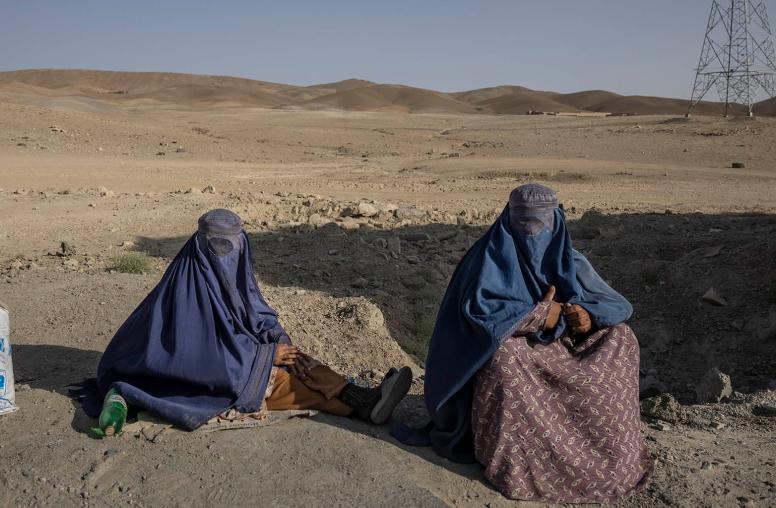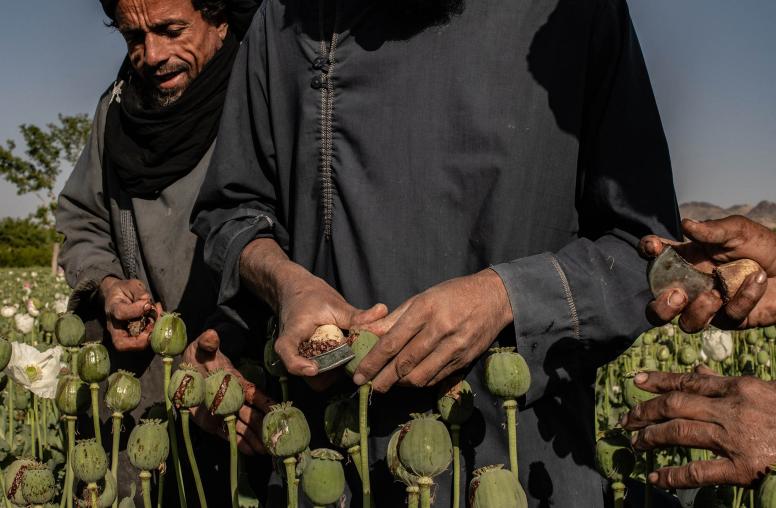Afghan Government Revenue, Critical for Peace, Grows in 2019
While gains stem largely from a weakening currency, the country has built a cash cushion against crisis.
An Afghanistan peace deal, currently under discussion between the Taliban and U.S., will depend in the long term on more than political and military agreements. A sustained peace will also require that the Afghan government can generate growing revenue to help pay its soldiers, deliver services and reduce its dependence on foreign aid. As with any country, Afghanistan’s government revenue is an important fiscal indicator and determinant of macroeconomic stability; in Afghanistan, it will also be critical to stabilizing the country should a peace agreement materialize.

Afghanistan’s revenue picture today is decidedly mixed. On the bright side, total revenues have grown significantly since the fiscal crisis of 2014, an expansion—and improved cash position—that has extended into 2019. There is no question that the government is better situated now than it was immediately before the crisis five years ago. On the other hand, most of the apparent improvement—at least in 2019—can be attributed to the weakening of the Afghan currency against the U.S. dollar, a development that offers no sustainable path to long-term revenue growth.
For those concerned about the prospects for a lasting peace, a closer look at the numbers is warranted.
Since the fiscal crisis around the 2014 presidential election, Afghanistan’s total revenue has recovered strongly and has grown rapidly—by about 22 percent in 2015, 20 percent in 2016, 15 percent in 2017, and 12 percent in 2018. In 2018, total revenue was almost 90 percent higher than in 2014 in nominal Afghan currency (Afghanis), and rose to 13.4 percent of gross domestic product last year from its nadir of 8.5 percent in 2014.
This constitutes a rare bright spot in Afghanistan’s otherwise bleak fiscal and economic landscape. Even so, government revenue did not surpass its 2011-12 peak of 11.7 percent of GDP until 2017. In short, a half-decade of progress on the revenue front was lost because of the economic shock triggered by the drawdown of U.S. and international troops from 2011 to 2014, the lingering effect of the 2014 fiscal crisis, and the political uncertainty that has plagued Afghanistan’s current National Unity Government during much of its tenure.
Impressive Revenue Performance in 2019?
Robust revenue growth has continued in the first half of 2019, with total government revenue up by 15.1 percent from the same period in 2018. This looks impressive, especially considering the negative forces weighing on collections. They include Afghanistan’s weak economy, which may not have grown at all in 2017 and 2018; widespread physical insecurity; uncertainties over the upcoming presidential election; ongoing peace talks; and questions about the longevity of the U.S. and international troop presence.
Another optimistic note is that by June the government had cash reserves of Afs 81 billion (more than $1 billion) with the Central Bank (Da Afghanistan Bank), up from Afs 74 billion at the end of 2018. This accumulated cash cushion contrasts sharply with the situation in June 2014. As the fiscal crisis unfolded that year, cash reserves fell to less than Afs 3 billion, reaching the point where the government could no longer manage its daily cash flow and pay its bills.
Among the three broad categories of revenue, customs duties and other tax revenues increased by 11.9 percent and 11.6 percent respectively in the first half of 2019 compared to the first half of 2018, while non-tax revenues (transfers from state-owned enterprises, fees and service charges, and the like) soared by 21.9 percent.
Behind the Headline Numbers
To see whether the 2019 increase stemmed from revenue mobilization efforts or extraneous, one-time events requires a deeper look at the drivers behind each category.
Inflation and economic growth have been very low and therefore would not have had much impact in augmenting nominal government revenues in Afghanis.
However, the 9 percent depreciation of the Afghani against the U.S. dollar between the first half of 2018 and first half of 2019 artificially inflated customs receipts (including both customs duties and other taxes collected by customs departments at the border). This is because the same receipts valued in U.S. dollars yield a higher amount denominated in Afghanis than in the first half of last year. Moreover, there was a one-time, Afs 8.9 billion transfer of administrative profits from the Central Bank to the budget in the first half of 2019. These Central Bank profits also stem almost entirely from the depreciation of the Afghani currency, which appears to have generated gains from foreign exchange transactions and asset valuations.
Taking the currency depreciation into account, the underlying growth of total customs receipts was almost negligible (0.5 percent); the vast bulk of their increase in nominal Afghani terms is attributable to currency depreciation, not enhanced revenue mobilization efforts. Moreover, once the Central Bank’s one-time transfer is subtracted, non-tax revenue drops from a 21.9 percent increase to a decline of 11.7 percent. Only the growth of taxes collected by the Afghan Revenue Department holds up and remains in the double digits.
Overall, after these adjustments, there has been little or no underlying growth in total revenue in the first half of 2019. Indeed, adjusted for currency depreciation and the Central Bank transfer, revenue shrank by 0.4 percent from the first half of last year. This suggests that the headline revenue growth of more than 15 percent was not due to more effective, sustainable revenue mobilization efforts.
Avoiding a Crisis
Nevertheless, Afghanistan has at least so far avoided letting revenue performance openly deteriorate in 2019, unlike the situation in 2014 leading up to the fiscal crisis. Beyond earlier warnings to avoid falling into such a crisis again, both the international community and the Afghan government appear to be determined not to let revenue performance sharply deteriorate this year. This is evidenced not least by more intensive monitoring of the latest revenue statistics, now publicly available on a weekly basis from the Ministry of Finance.
A critical question is whether—and how—decent revenue performance can be maintained through 2019 and sustained over the next several years. The deceleration of revenue growth over recent years, which fell from a 22 percent increase in 2015 to 12 percent in 2018, gives grounds for concern as does the continuing stagnation of the Afghan economy and the resulting lack of tax-base expansion.
The Afghani will likely remain depressed against the dollar and very possibly depreciate further, providing a continuing artificial boost to customs receipts. Moreover, it would be only natural for revenue collection to slip during the election period, especially if the process is disputed or delayed, as well as during ups and downs of peace negotiations.
Looking Ahead
Sustaining robust revenue growth in coming years will require economic expansion, buoyancy of the existing tax system (meaning whether revenue growth will keep up with or better yet exceed the growth of the economy), and broadening the tax base, which is currently very narrow.
Economic growth will, in the first instance, depend on real progress toward peace (especially a durable cease-fire) and at least a modicum of political stability (including not least an accepted outcome of the scheduled presidential election). Tax system buoyancy, in turn, will be critical if the Afghan economy starts growing again—so that government revenues at least maintain or rise as a share of GDP by growing faster than the economy as a whole. And over the medium- to longer-term, base-broadening will be essential.
With regard to base-broadening, one question is whether, and how quickly and effectively, the Afghan government can implement its ambitious but long-delayed plan for a value-added tax (VAT).
The longer-term benefits of VAT, in providing strong positive incentives for base-broadening and avoiding cascading taxation of multiple transactions along the value chain, are unquestionable. Moreover, VAT allows zero-rating of exports so they are not at a competitive disadvantage vis-à-vis other WTO-compliant countries.
Transitioning from the current Business Receipts Tax will not be easy, however. The BRT—effectively a turnover tax—has been fairly buoyant and is a significant source of revenue, though a fully functioning VAT system could bring in more and faster growing revenue. It seems particularly difficult to introduce VAT amid multiple other complex, challenging political and security transitions. Moreover, given anticipated leakages (falsification of VAT invoices and the like), the rate of VAT would have to be higher than the existing BRT rate of 4 percent, with VAT rates as high as 10 percent being advocated from some quarters.
Aid in Pursuit of Peace
No matter how much Afghan government revenue can feasibly improve, the country will continue to rely on international assistance to support its budget. Any sudden halt or abrupt cut in aid would precipitate a fiscal crisis, which would lead to dissipation of the Afghan security forces when soldiers aren’t paid and the likely collapse of the state. Under such circumstances, sustaining progress toward peace or a peace agreement would be impossible. Maintaining a predictable, steady glide-path for gradually declining international support to the Afghan budget is essential to the pursuit of peace.
More broadly, reviving the Afghan economy and spurring robust economic and revenue growth over the medium-term will significantly improve the chances that any peace deal will endure and that Afghanistan, after more than 40 years of violent conflict, will not relapse into war.
William A. Byrd is a senior expert at the U.S. Institute of Peace. M. Khalid Payenda is a senior fellow at the Institute of State Effectiveness and former deputy finance minister of the Islamic Republic of Afghanistan. The views expressed are their own.



